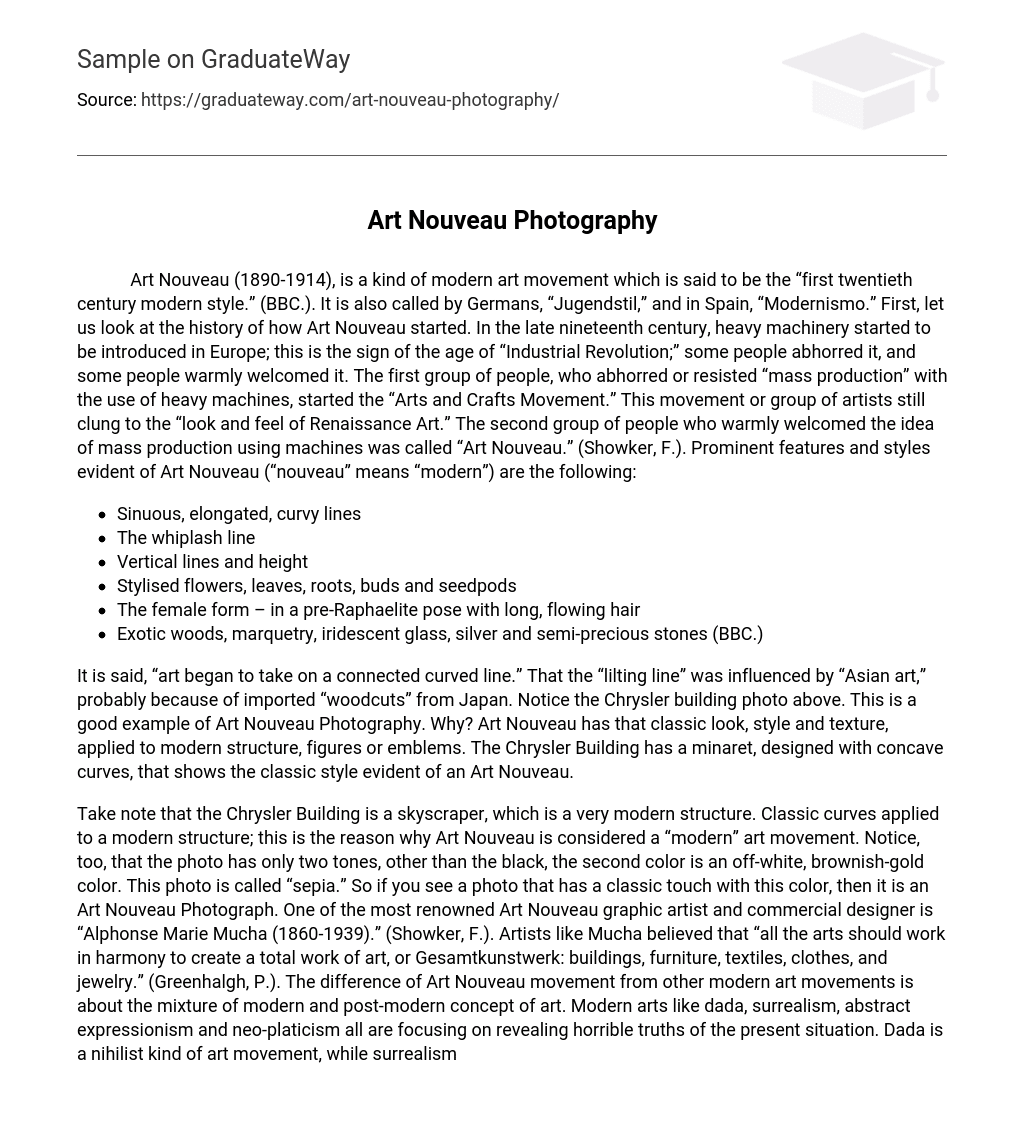Art Nouveau (1890-1914), is a kind of modern art movement which is said to be the “first twentieth century modern style.” (BBC.). It is also called by Germans, “Jugendstil,” and in Spain, “Modernismo.” First, let us look at the history of how Art Nouveau started. In the late nineteenth century, heavy machinery started to be introduced in Europe; this is the sign of the age of “Industrial Revolution;” some people abhorred it, and some people warmly welcomed it. The first group of people, who abhorred or resisted “mass production” with the use of heavy machines, started the “Arts and Crafts Movement.” This movement or group of artists still clung to the “look and feel of Renaissance Art.” The second group of people who warmly welcomed the idea of mass production using machines was called “Art Nouveau.” (Showker, F.). Prominent features and styles evident of Art Nouveau (“nouveau” means “modern”) are the following:
- Sinuous, elongated, curvy lines
- The whiplash line
- Vertical lines and height
- Stylised flowers, leaves, roots, buds and seedpods
- The female form – in a pre-Raphaelite pose with long, flowing hair
- Exotic woods, marquetry, iridescent glass, silver and semi-precious stones (BBC.)
It is said, “art began to take on a connected curved line.” That the “lilting line” was influenced by “Asian art,” probably because of imported “woodcuts” from Japan. Notice the Chrysler building photo above. This is a good example of Art Nouveau Photography. Why? Art Nouveau has that classic look, style and texture, applied to modern structure, figures or emblems. The Chrysler Building has a minaret, designed with concave curves, that shows the classic style evident of an Art Nouveau.
Take note that the Chrysler Building is a skyscraper, which is a very modern structure. Classic curves applied to a modern structure; this is the reason why Art Nouveau is considered a “modern” art movement. Notice, too, that the photo has only two tones, other than the black, the second color is an off-white, brownish-gold color. This photo is called “sepia.” So if you see a photo that has a classic touch with this color, then it is an Art Nouveau Photograph. One of the most renowned Art Nouveau graphic artist and commercial designer is “Alphonse Marie Mucha (1860-1939).” (Showker, F.). Artists like Mucha believed that “all the arts should work in harmony to create a total work of art, or Gesamtkunstwerk: buildings, furniture, textiles, clothes, and jewelry.” (Greenhalgh, P.). The difference of Art Nouveau movement from other modern art movements is about the mixture of modern and post-modern concept of art. Modern arts like dada, surrealism, abstract expressionism and neo-platicism all are focusing on revealing horrible truths of the present situation. Dada is a nihilist kind of art movement, while surrealism is an escape from reality jumping into a dream; abstract expressionism and neo-platicism both express the real feelings of the artist on issues of the present situation. They are much like propagandas. Art Nouveau is an embrace of the modern and post-modern; hard machinery of the Industrial Revolution softened by the touch of nature and women.
The influence of Art Nouveau gave birth to “Victorian furniture, Tiffany” lamps, and “artsmiths” who used “flowing lines,” soft tones and “beautifully sullen women.” It also started the design of structures with “iron” at the start of the twentieth century. If you see iron grills with vine-like designs, you’ll know where the influence came from. The Art Nouveau Movement inspired greatly “artists, illustrators, and the printing trade in America, including the 60’s hippies movement.” It is also continuously used in “visual communications industry,” of the modern era. Until today, this kind of art movement had been used to show elegance, class, and feminine beauty in this hard, rigid world. (Showker, F.).
Works Cited
- Sohm, J., Corbis. 2008. Chrysler Building in New York at sunset – 1999. The New York Times. Retrieved June 6, 2008. [http://images.google.com.ph/imgres?imgurl=http://img.nytstore.com/IMAGES/NSAPCP5LF-BLWH_LARGE.JPG&imgrefurl=http://www.nytstore.com/ProdDetail.aspx%3FprodId%3D14335&h=350&w=350&sz=20&hl=tl&start=169&um=1&tbnid=poSKIo-vg7AhuM:&tbnh=120&tbnw=120&prev=/images%3Fq%3Dchrysler%2Bbuilding%26start%3D162%26ndsp%3D18%26um%3D1%26hl%3Dtl%26sa%3DN].
- Showker, F. Art Nouveau. 1996-1999. DT&G Magazine. The Design Center Publications. Retrieved June 6, 2008. [http://www.graphic-design.com/DTG-Library.html.].
- Greenhalgh, P. 2000. Introduction to Art Nouveau. National Gallery of Art Anatomy of an Exhibition. Washington, D.C.: National Gallery of Art. Retrieved June 6, 2008. [http://www.nga.gov/feature/nouveau/exhibit_intro.shtm].
- Period style. Homes. Bbc.co.uk. Retrieved June 6, 2008. [http://www.bbc.co.uk/homes/design/period_artnouveau.shtml].





